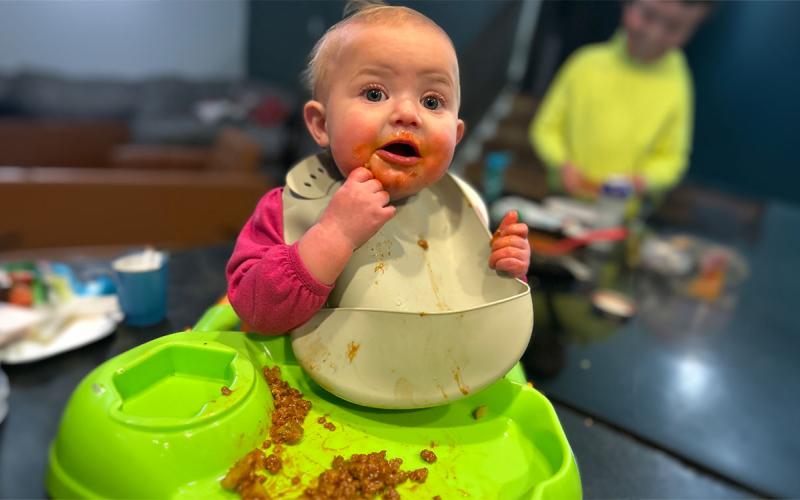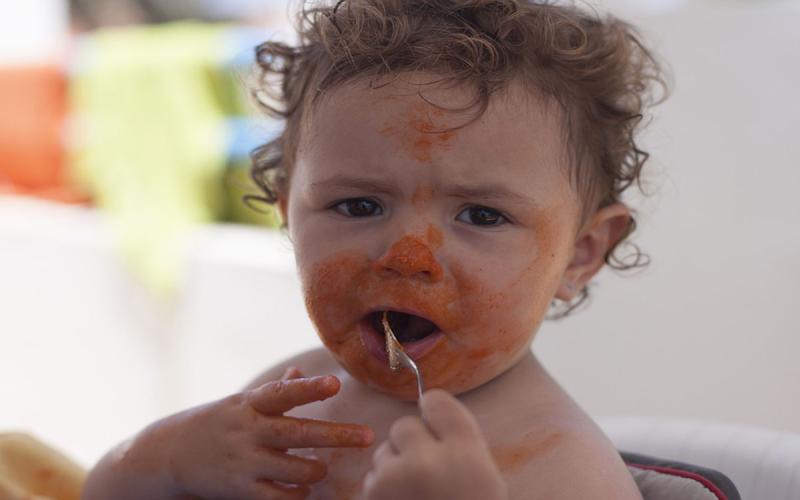
Written by Cydney Chamberlain, SDSU Extension Dietetic Intern, under the direction and review of Anna Barr, former SDSU Extension Farm to School Nutrition Field Specialist.
What is baby-led weaning?
Baby-led weaning (BLW) has gained a lot of attention in the last few years. You may hear parents or some healthcare providers talking about it, but what is it? BLW is a method of introducing solid foods where the infant takes the lead on the process. This method allows parents to give their infants regular table food instead of using pureed baby foods or infant cereals. There are many pros to using BLW, as well as common concerns parents may have.
What are the benefits?
This method of weaning has a lot of upsides to it. The infant can learn how to regulate their hunger, develop their fine motor skills, explore different foods and it is cheaper. Offering the infant foods that the family eats will help them explore these new foods and their bodies. Adults know how to tell when they are full or hungry, but infants must figure this out. Exploring is the best way to do this. There may be a mess, but this is all part of the process. BLW also tends to be cheaper, since the parents typically offer foods they are already buying for themselves, as long as they are safe.
When can you start?
The American Academy of Pediatrics recommends exclusive breastfeeding or infant formula for the first six months of life. After this, parents can start to introduce solid foods. Food before the age of one is mostly bonus calories. Infants are still getting the majority of their nutrients from breastmilk or formula. Signs of readiness include the infant can sit up by themselves with little to no support, they open their mouth and lean forward when food is offered, grabbing for food or toys and bringing them to the mouth and the palmar grasp. The palmar grasp is when an infant grasps something with their whole hand, such as when they grab a parent’s finger. This grasp allows them to have a firm hold on food.
Which foods are safe?
The biggest concern with BLW is choking. BLW does not put infants at a greater risk of choking than spoon-feeding with baby food. The most important things to remember when using BLW are to only offer safe foods and never leave an infant unattended while eating.
The food should be long enough for the infant to grab and be able to gnaw at. It is also important to note that infants should not be given added salt. Parents can use other seasonings on the food or keep it plain when cooking for their infant.
Examples of safe foods:
- Scrambled eggs
- Avocado strips
- Banana sticks
- Boiled apple slices
- Mango slices
- Chicken, freshly made and cut into strips
- Big pieces of pasta (rotini, cavatappi, lasagna, etc.)
- Pancake strips
- Toast with a light spread of peanut butter or hummus
- Roasted broccoli (no salt)
- Roasted sweet potato (no salt)
Foods to avoid:
- Dry Toast
- Popcorn
- Nuts and seeds
- Hot dogs
- Carrots
- Crackers
- Corn
In Summary
BLW can be a great option if parents are interested. What works for one family may not work for another, so make sure to do what you are most comfortable with. Always consult with a registered dietitian or the infant’s pediatrician with any concerns or questions about BLW.
Additional Resources
- American Academy of Pediatrics News & Journals. Baby-led weaning: a good idea or not?.
- Cleveland Clinic. 8 Tips for Introducing Solid Foods With Baby-Led Weaning.
- Utah State University Extension. Baby-Led Weaning: An Approach to Introducing Solid Foods to Infants.


